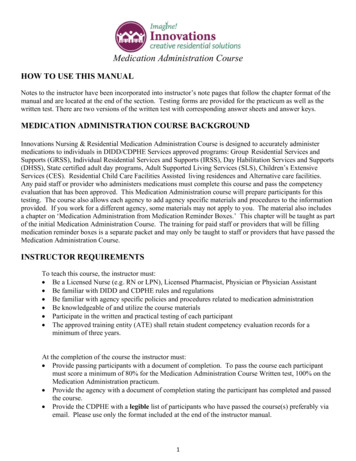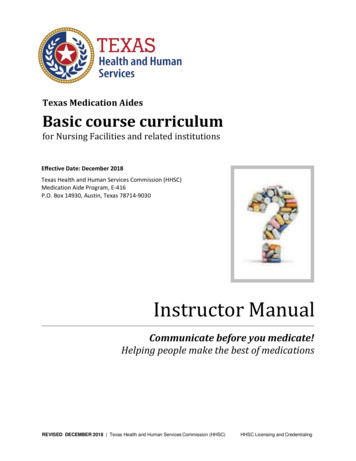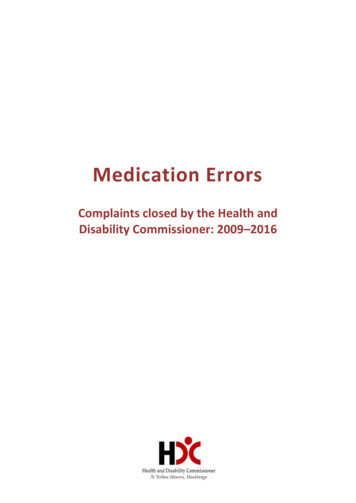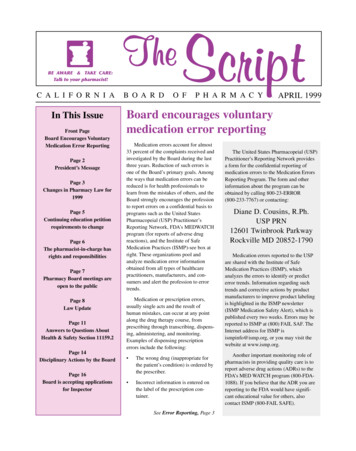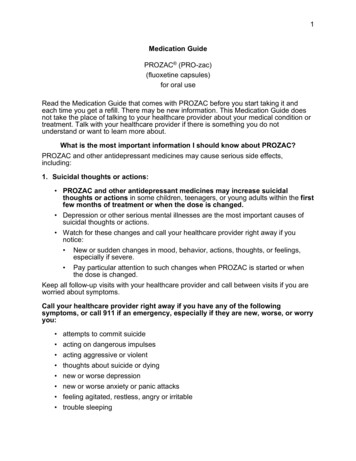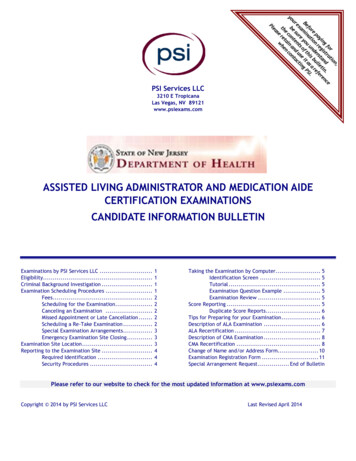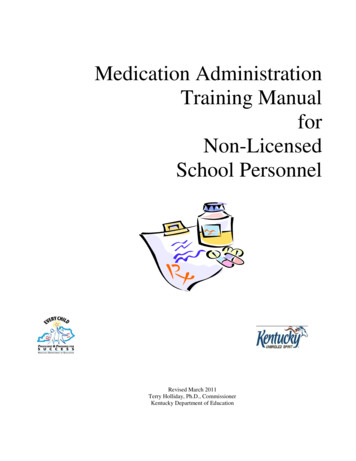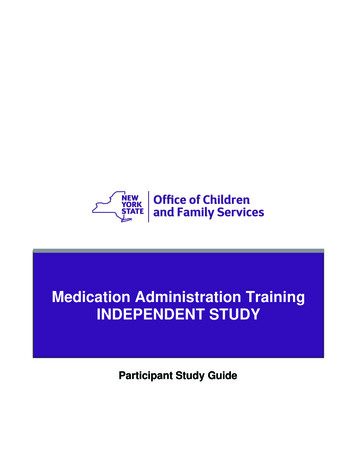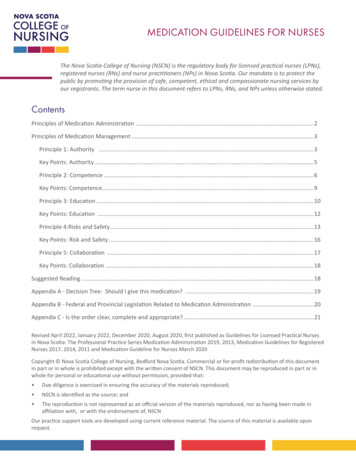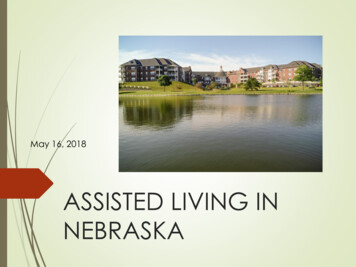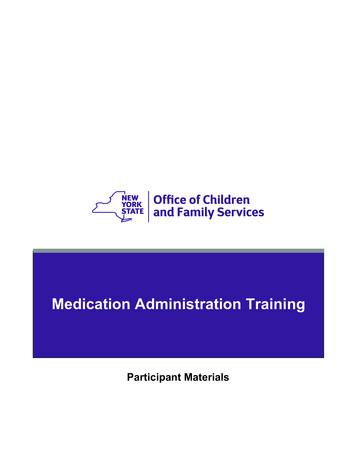
Transcription
Medication Administration TrainingParticipant Materials
This document is provided under a contractual agreement between theNew York State Office of Children and Family ServicesDivision of AdministrationBureau of Training and DevelopmentANDProfessional Development ProgramRockefeller College of Public Affairs & PolicyUniversity at AlbanythroughThe Research Foundation for The State University of New YorkAcknowledgementThis material was developed by the Professional Development Program, Rockefeller College of Public Affairs& Policy, University at Albany, through The Research Foundation for The State University of New York, under atraining and administrative services agreement with the New York State Office of Children and Family Services.DisclaimerWhile every effort has been made to provide accurate and complete information, the Office of Children andFamily Services and the State of New York assumes no responsibility for any errors or omissions in the information provided here and makes no representations or warranties about the suitability of the information contained here for any purpose. All information and documents are provided “as is,” without a warranty of any kind.Copyright 2019 by The New York State Office of Children and Family ServicesApril 2019
Medication Administration Training (MAT)Participant MaterialsTABLE OF CONTENTSHandout 1.1: Medication Administration Training (MAT) Resource Materials. 1Handout 1.2: Medication Administration Training (MAT) Overview. 3Handout 1.3: Glossary. 5Handout 2.1: What Are the Five Rights?.11Handout 2.2: Matching the Five Rights. 13Handout 2.3: OCFS-LDSS-7002: Written Medication Consent Form . 15Exercise 2.1: Finding the Five Rights. 17Answer Key 2.1: Finding the Five Rights. 25Handout 3.1: Medication Effects. 33Handout 3.2: Medication Routes. 35Handout 3.3: Overview of the Medication Routes Covered in the MAT Course. 37Handout 3.4: Types of Medication. 39Exercise 3.1: Handling Effects from Medication. 41Exercise 3.2: Identifying Types of Medication. 43Answer Key 3.1: Handling Effects from Medication. 45Answer Key 3.2: Identifying Types of Medication. 49Handout 4.1: What Permissions and Instructions Do I Need to Give Medication?. 51Handout 4.2: OCFS-LDSS-7002: Written Medication Consent Form . 53Handout 4.3: Common Medical Abbreviations. 55Handout 4.4: OCFS-LDSS-7004: Log of Medication Administration . 57Handout 4.5: Good Documentation. 59Handout 4.6: OCFS-LDSS-7003: Verbal Medication Consent Form and Log of Administration . 61Handout 4.7: Medication Storage. 63Handout 4.8: Accepting Medication. 67Handout 4.9: Administration Tools and Medication Label Requirements. 69Handout 4.10: Medication Label Does Not Match Consent Form. 71Handout 4.11: Planning Your Day. 73Exercise 4.1: Accepting Medication. 75Answer Key 4.1: Accepting Medication. 79Medication Administration Training (MAT) Participant Materials (rev Apr 2019)Page i
Handout 5.1: Giving Medication to Children. 83Handout 5.2: Special Situations. 85Handout 5.3: Giving Medication Safely. 87Handout 6.1: Hand Washing. 89Handout 6.2: Using Gloves. 91Handout 6.3: Cleaning and Sanitizing. 93Handout 7.1: Applying Medication Topically. 95Handout 7.2: Applying Medicated Patches. 97Handout 7.3: Giving Medication by Mouth. 99Handout 7.4: Measuring Liquid Medication. 101Handout 7.5: Giving Medication Inhaled by Mouth. 105Handout 7.6: Giving Medication Inhaled Through the Nose. 107Handout 7.7: Giving Medication in the Eye. 109Handout 7.8: Giving Medication in the Ear.111Skills Practice 7.1: Giving Liquid by Mouth.113Skills Practice 7.2: Oral Liquid Consent Form.115Skills Practice 7.3: Skills Practice Log.117Skills Practice 7.4: Pharmacy Print-Out: Amoxicillin.119Skills Practice 7.5: Evaluation Chart for Skills Demonstration. 121Skills Practice 7.6: Tools—Matching the Five Rights . 125Skills Practice 7.6: Tools—Giving Medication Safely. 126Skills Practice 7.6: Tools—Measuring Liquid Medication. 127Handout 8.1: Asthma Facts. 131Handout 8.2: Asthma Treatment. 133Handout 8.3: Example of a Care Plan for a Child with Asthma. 135Handout 8.4: New York State Department of Health Asthma Action Plan. 139Handout 9.1: Preventing Unintentional Medication Poisoning. 141Handout 9.2: Anaphylaxis. 143Handout 9.3: Epinephine Auto-Injector (EpiPen or Auvi-Q ) Use and Storage. 145Handout 9.4: How a Child Might Describe a Reaction. 148Handout 10.1: Medication Errors. 149Handout 10.2: OCFS-LDSS-7005: Medication Error Report Form. 151Handout 10.3: Independent Medication Administration. 153Handout 10.4: Children with Special Health Care Needs. 155Handout 10.5: OCFS-LDSS-7006: Individual Health Care Plan for a Childwith Special Health Care Needs . 157Medication Administration Training (MAT) Participant Materials (rev Apr 2019)Page ii
Handout 10.6: Giving Medication when Away from the Program. 159Handout 10.7: First Aid Kit. 161Handout 11.1: Next Steps. 163MAT Reaction Questionnaire. 165Medication Administration Training (MAT) Participant Materials (rev Apr 2019)Page iii
This page is intentionally blank.Medication Administration Training (MAT) Participant Materials (rev Apr 2019)Page iv
Handout 1.1Medication Administration Training (MAT)Resource MaterialsThe Medication Administration Training (MAT) course is approved by the Office of Childrenand Family Services (OCFS) and is designed to teach you best practice techniques for givingmedication and to help you understand OCFS regulations about giving medication.RegulationsRegulations create the basic structure for the way child day care programs operate. Theyestablish minimum standards for the quality of each program. As a child day care provider, youare responsible for knowing what is required by law and regulation. This course covers OCFSregulations about giving medication in your program.Your MAT Trainer has a copy of the regulations available throughout this training. You shouldalways have the most current version of the OCFS regulations at your program. Periodicallycheck the OCFS website (www.ocfs.ny.gov) for any changes.HandoutsThere is a lot of information covered in the MAT course, both on video and in your handouts.You do not need to memorize the information in the training. The information provided onthe video is also in your handouts. These handouts are yours to keep and you can use themthroughout the training and in your program.Handouts are sometimes updated with new information. The most current version of all of theMAT handouts is available at www.ecetp.pdp.albany.edu. The handouts have a date printed onthe bottom of the page. The website will also have the date the handout was last updated. Youshould check the website on a regular basis for updates.OCFS FormsYour MAT handouts include forms approved by OCFS. The MAT course uses the most currentversion of the forms approved by OCFS. You should periodically check the OCFS website(www.ocfs.ny.gov) for the most current version or if you want an electronic version of theform(s).Health Care PlansYour MAT Trainer has copies of each modality’s health care plan template approved by OCFS.Your program must have a health care plan approved by OCFS. You should know what is writtenin your program’s health care plan and follow the policies and procedures it contains.Medication Administration Training (MAT) Participant Materials (rev Apr 2019)Page 1
This page is intentionally blank.Medication Administration Training (MAT) Participant Materials (rev Apr 2019)Page 2
Handout 1.2Medication Administration Training (MAT)OverviewGiving Medication in a Child Care ProgramThe following are not considered medication and may be given with the written permission ofthe parent: Sunscreen Topically applied insect repellent Over-the-counter topical ointments (This includes ointments, creams, gels and lotions.)However, if the package directions indicate to consult a doctor, you need written instruction fromthe child’s health care provider before you can give it.If the child needs medication other than what is listed above, you need to be approved to givemedication. Part of the approval process is getting a Medication Administration Training (MAT)certificate.About the MAT Course The MAT course trains child day care providers to safely give medication to children ina child care setting. It’s approved by the New York State Office of Children and FamilyServices (OCFS).In this course, you’ll learn seven ways to give medication: On the skin (topically) By mouth (orally; includes topically applied in the mouth) Inhaled (the child breathes it in through his nose or mouth) By using medicated patches By putting it in the ear By putting it in the eye By using an auto-injector, like an EpiPen , to give a shot of epinephrineYou must pass a written test and the skills demonstrations to get a MAT certificate at theend of the course.To pass the course you must be able to: Read and understand the information that comes with the medication in the languagein which it is written. This includes medication labels, inserts and print-outs from thepharmacy.Read and understand the instructions from the parent and health care provider.Read and understand the parental permission forms.Write down that you have given the medication.Read, understand and be able to follow step-by-step instructions for the safeadministration of medication.Medication Administration Training (MAT) Participant Materials (rev Apr 2019)Page 3
Handout 1.2TestingYou will be tested on the information included in the MAT handouts and video only. You can useall of the MAT handouts when you take the test.Written Test The test is 60 multiple-choice questions.You must get an 80% or above to pass the test.If you don’t pass the written test on your first try, you can take another test withdifferent questions. If you don’t pass the test on your second try, you will need tocomplete the full MAT course again.Skills DemonstrationsYou must show a trainer that you can: Match the Five Rights of safe medication administration. You can read about theFive Rights on Handout 2.1. Safely give medication by one of the routes listed here: Orally (by mouth) Topically (on the skin) Inhaled into the mouth or nose In the eye In the ear By applying a medicated patchYou will be tested on only one route, but you must be prepared to give medicationby any route listed above, since you will not know until the testing time which routeyou’ll be tested on. There is an example of this on the video to help you get ready. Correctly measure liquid medication using: a medicine cup; a dosing spoon; or an oral medication syringe. Correctly administer epinephrine using an auto-injector.An approved MAT trainer will watch you complete each of these skills. If you don’t passon your first try, you can try again. You may be tested on the same route again or on adifferent route.If you don’t pass on your second try, you must take the course again.Individuals Who Are NOT Required to Attend MAT TrainingA person who can produce a valid New York State license as a physician, physicanassistant, registered nurse, nurse practitioner, licensed practical nurse or advancedemergency medical technician will not be required to attend MAT training in order toadminister medication in a day care program.Documentation establishing the person’s credentials in one of the above fields will berequired and a copy of the documentation must be included with the Health Care Plan.Medication Administration Training (MAT) Participant Materials (rev Apr 2019)Page 4
Handout 1.3GlossaryUse this glossary of selected words and phrases to help you to understand how they are used inthe MAT course.abbreviationShort form or symbol used in place of complete word.acronymA word formed from the first letter(s) of each part of a compound term.(For example, MAT Medication Administration Training.)active ingredientThe main component of the medication that produces the medication’sdesired effect.acute illnessSickness that begins quickly and lasts only a short time. Someexamples are ear infections and common colds.administrationThe act of giving.adverse effectUnexpected reaction of a medication that can be potentially harmful.allergic reactionA potentially harmful immune response to a foreign substance,including medication. Allergic reactions occur when the immunesystem overreacts to a substance called an allergen. These reactionsdo not always occur the first time the child comes in contact with theallergen and may get worse with each exposure.anaphylaxisA severe and potentially life-threatening sudden allergic reactiontypically characterized by hives, swelling, shortness of breath andrequiring immediate treatment. See Handout 9.2.Americans withDisabilities Act of1990 (ADA)A law prohibiting discrimination on the basis of disability.See www.ada.gov.asthmaA chronic condition characterized by severe difficulty breathingcaused by a spasm of the bronchial tubes or by swelling of mucousmembranes caused by a response to a trigger and/or an allergen.See Handout 8.1.as neededmedicationMedication given to treat specific symptoms at non-specific times,often to relieve or control symptoms that may recur from a knowncondition. See “PRN” in this glossary.auto-injectorDevice for delivering an injection by an automatic system.See “epinephrine” in this glossary.Medication Administration Training (MAT) Participant Materials (rev Apr 2019)Page 5
Handout 1.3brand nameA name given to the medicine by the pharmaceutical company thatcreated it. The name is followed by the symbol , which indicates thatthe name is a registered trademark.children with special Children with a chronic physical, developmental, behavioral orhealth care needsemotional condition expected to last 12 months or more that requireshealth and related services of a type or amount beyond that required bychildren generally. See Handout 10.4 and NYS Day Care Regulation413.2(am).chronic illnessSickness or disease that is of long duration. It cannot be cured and willnot go away. Some examples are asthma and diabetes.controlledsubstanceAny substance the federal government has classified as having a highrisk for misuse. Rules for prescribing and storing these substances aremade by the federal government. A list of controlled substances can beobtained from the Drug Enforcement Administration. Some examplesare Ritalin and codeine.consanguinityA close relation or connection. A relative within the third degree ofconsanguinity of the parent or step-parent includes: the grandparentsof the child; the great-grandparents of the child; the great-greatgrandparents of the child; the aunts and uncles of the child, includingthe spouses of the aunts and uncles; the great-aunts and great-unclesof the child, including the spouses of the great-aunts and great-uncles;the siblings of the child; and the first cousins of the child, including thespouses of the cousins.contaminatedAny substance or material that was exposed to body fluids, blood orairborne infectious materials. See Handout 6.2.CPRAn acronym for Cardio-Pulmonary Resuscitation.curvatureThe bending of a line or surface. For this training, the term appliesto the slope or curve seen when looking at the measurement of aliquid medication at eye level. The lowest point of the curvature isthe point for measuring the correct amount of the medication ordered.See Handout 7.4.demonstrationTo perform physically or act out the steps to show understanding ofsafe medication principles. See Module 7.desired effectThe beneficial and sought-after effect of the medication.disposalDiscarding medication that is expired, damaged or no longer needed.See Handout 4.7.Medication Administration Training (MAT) Participant Materials (rev Apr 2019)Page 6
Handout 1.3epinephrineA medication used to quickly relieve severe allergic reactions(anaphylaxis) until more medical care is available. This must be givenby injection. See Module 9.expired medicationMedication that can no longer be guaranteed as safe and effective,since either chemical breakdown or contamination may have occurredby the expiration date. A medication label may indicate “discardafter” a specific date on the label. If the medication package gives anexpiration date with a month and year only, the medication is gooduntil the last day of the month.Five RightsThe five pieces of information necessary to administer medicationcorrectly. The Five Rights include: child, medication, route, time, anddose. Matching the Five Rights each time medication is given will helpprevent medication errors. See Handout 2.1 and 2.2.generic nameThe name of the medication that is the same as the medication’s activeingredient.health careconsultantA physician, physician assistant, nurse practitioner or registered nursewith a valid New York State license. The consultant is responsible forworking closely with the child care program to develop and implementa safe and realistic health care plan that includes the administration ofmedication in the program. See NYS Day Care Regulation 413.2(ak).health care providerA licensed physician, physician assistant or nurse practitioner with avalid New York State license. See NYS Day Care Regulation 413.2(q).hivesA skin condition characterized by itching and welts, caused by areaction to internal or external agents, an infection or a nervouscondition.illnessThe state of being sick.ineffectiveThe absence of a desired effect, after allowing sufficient time for themedication to work.inhalerA device for administering medication into the nose, lungs or otherpart of the respiratory tract by breathing in the medication.independentmedicationadministrationWhen a child carries his own medication, decides when a dose isneeded and takes the dose without supervision. See Handout 10.3.infantA child who is younger than eighteen (18) months of age. See NYSDay Care Regulation 413.2(s).Medication Administration Training (MAT) Participant Materials (rev Apr 2019)Page 7
Handout 1.3licensed authorizedprescriberA person licensed, currently registered and authorized under NYSEducation Law to issue prescriptions for medication or medicaltreatment. Also called prescriber. See NYS Day Care Regulation413.2(al).localizedConfined or restricted to a particular location. The use of this term inthis curriculum refers to how a mild allergic reaction might appear ona child’s body part (e.g., a localized red skin rash on the stomach or alocalized region of hives on the neck).Log of MedicationAdministrationThe OCFS-approved form that provides a written record for eachmedication given to a specific child.MATAn acronym for the Medication Administration Training course.MDIAn acronym for Metered Dose Inhaler device. A metered-dose inhaleris used to deliver a precise dose of medication from a multi-dosecontainer into the lungs.medicationAny non-food substance used to treat a disease or illness or used toprevent or cure health problems.medicationadministrantA staff person who is listed in the day care program’s approved healthcare plan as authorized to give medication in the program. This personmust be at least 18 years old, have current CPR and first aid certificatescovering the ages of the children in care and have a current MATcertificate. Only medication administrants approved by OCFS cangive medication.medicationadministrationThe complete process of giving medication, observing and reportingdesired and undesired effects and reviewing each step to maximizebenefit and reduce risk.medication category A type or common grouping of medicine based on its purposes orgeneral function.medication effectsHow medication affects the child. These effects may be desired orundesired.medication errorA mistake made in giving the medication (for example, giving theincorrect medication, giving the medication at the incorrect time,giving the incorrect dose, using the incorrect route, giving themedication to the incorrect child, giving an expired medication,forgetting to give medication or giving medication when the child’swritten medication consent form or the medication is expired).See Handout 10.1.Medication Administration Training (MAT) Participant Materials (rev Apr 2019)Page 8
Handout 1.3medication labelThe label on the pharmacy bottle or container that contains theinformation necessary to administer the medication safely.medication packageThe container in which the medication is supplied. This maysometimes contain important information such as side effects, specialconsiderations and drug/food interaction.mucous membraneA membrane that lines body passages and cavities that are connectedto the outside of the body. One example is the lining of the noseand mouth.nebulizer machineA compressor device that finely disperses a liquid drug for inhalationin a mist to be breathed into the body. This machine is used frequentlyfor the treatment of asthma in children. See Handout 7.5.non-infantA child who is eighteen (18) months of age or older.nonprescriptionmedicationMedication that can be bought without a prescription from a licensedauthorized prescriber. Also called over-the-counter medication.NYSAcronym for New York State.OCFSAcronym for the Office of Children and Family Services.OCFS is the New York State agency responsible for the regulationsgoverning the safety and well-being of children receiving child carein New York State.OTC medicationAn acronym for over-the-counter medication.over-the-countermedicationAnother term for nonprescription medication. See “nonprescriptionmedication” in this glossary.package insertThe information provided on a separate sheet accompanying themedication package or container. It includes common side effects,warnings and administration information. This information may beprinted directly on the medication package or container.peak flow meterA portable, handheld device used to measure how hard and fast thechild can push air out of the lungs. Measurements with a peak flowmeter help the child’s parent and physician monitor asthma. Thesemeasurements can be important in helping the child’s health careprovider prescribe medicines to control asthma.pharmacyA licensed establishment where prescription medications are filled anddispensed by a pharmacist licensed under the laws of the state where(s)he practices.Medication Administration Training (MAT) Participant Materials (rev Apr 2019)Page 9
Handout 1.3prescriptionmedicationMedication for a specific child that can only be bought with awritten order from a licensed authorized prescriber to treat a specificcondition.prescriberSee “licensed authorized prescriber” in this glossary.PRNAn acronym for the Latin pro re nata, meaning “as needed.”PRN medication is given when a child shows specific symptoms.routeThe way medication gets into the body; also called method ofadministration. See Handout 3.3.seizureA sudden attack, spasm, convulsion, extreme emotional change, orchange in consciousness, as in epilepsy or another disorder.side effectThe action of a drug other than the desired or sought-after effect.See Handout 3.1.symptomsPhysical or behavioral signs that you can see, hear, measure, or smellthat may tell you the child needs help, which may include givingmedication.undesired effectAny effect other than the desired effect. Undesired effects are alsocalled side effects, which include adverse effects and allergic reactions.See Handout 3.1.unintentionalpoisoningUnintended or unplanned ingestion of any substance, includingmedication. See Handout 9.1.verbal instructions/permissionsInstructions received orally from a parent or guardian and/or thelicensed authorized prescriber to administer medication. You can onlyaccept verbal permissions and instructions in certain circumstances.See Handout 4.1.waiver requestA written request from a day care program on an OCFS-approved formlooking for approval to meet the intent of the regulations in a mannerthat is not specifically written in the regulations. The program cannotimplement the waiver until OCFS approves the waiver request.written permission/instructionsPermission and instructions for administering medication written onthe OCFS-approved Written Medication Consent Form or approvedequivalent completed by the child’s parent/guardian and/or health careprovider. See Handout 4.1 and 4.2.Written MedicationConsent FormThe OCFS-approved form that provides written health care providerinstructions and parental permission for each medication given to aspecific child. There should be one form for each medication the childreceives while in care. See Handout 4.2.Medication Administration Training (MAT) Participant Materials (rev Apr 2019)Page 10
Handout 2.1What Are theFive Rights ?1. Right Child Make sure that the child you are about to give the medication to is the right child.If you care
Medication Administration Training (MAT) Participant Materials (rev Apr 2019) Page 1 Medication Administration Training (MAT) Resource Materials Handout 1.1 The Medication Administration Training (MAT) course is approved by the Office of Children and Family Services (OCFS) and is
